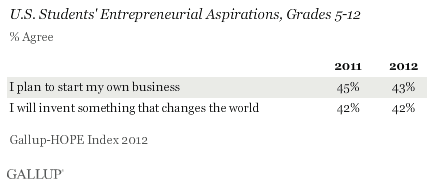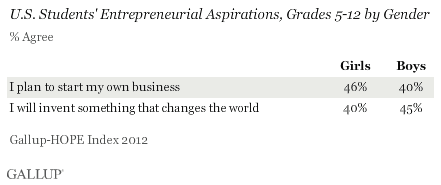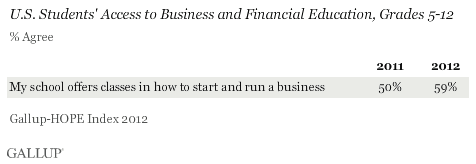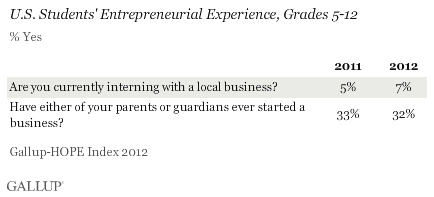WASHINGTON D.C. -- Entrepreneurial aspirations among fifth- through 12th-graders in the U.S. remained high and stable over the past year, according to the 2012 Gallup-HOPE Index. About four in 10 students (43%) say they plan to start their own business. Similarly, four in 10 students (42%) say they will invent something that changes the world.

Girls (46%) were slightly more likely to agree they plan to start their own business than boys (40%). Boys (45%) were slightly more likely than girls (40%) to say they will invent something that changes the world.

Entrepreneurship Prep Trails Aspirations
Despite the fact that many students have entrepreneurial aspirations, relatively few, including those who plan to start their own businesses, have any direct work experience in the world of business or entrepreneurship. Overall, just 22% of students worked one hour or more at a paying job in the last week, and far fewer (7%) say they are currently interning.
About one in four (26%) high school students in grades nine through 12 say they worked more than one hour at any paying job in the last week. Nineteen percent of younger students (grades five through eight) worked for one hour or more. Similarly, older students (10%) are slightly more likely than younger students (5%) to say they are currently interning with a local business.
Nearly six in 10 students (59%) say their school offers classes in how to start and run a business -- this is up from 2011.

About one-third (32%) of young people say their parents or guardians have started a business, which affords them a first-hand opportunity to see an entrepreneur in action. These students are somewhat more likely to say they plan to start their own businesses (49%) than those students whose parents are not business owners (40%). Practical work experience, in tandem with the guidance of a in a new or small-business environment, may be a key to helping youth realize their future entrepreneurial aspirations.

Closing the Gap Between Entrepreneurial Aspirations and Experience
U.S. cities must tap and ignite economic energy earlier and more intentionally in young Americans. With policies and curricula in place, leaders can begin to close the gap between entrepreneurial aspirations and attitudes in youth, on the one hand, and the lack of universal access to business/entrepreneurship education, practical work experience, and participation in the economy on the other. Successful small-business owners and entrepreneurs should invest in career literacy and education, and should partner with schools and educators to mentor and invest in young talent.
America needs to quickly develop a system to identify and equip young entrepreneurs who can rev up the nation's economic engine. This is critical to a future of continued global economic advantage and ensuring that generations of Americans can prosper and thrive.
Survey Methods
The Gallup-HOPE Index findings are based on results from a nationally representative poll of 1,217 students in grades five through 12. Telephone interviews were conducted as part of 优蜜传媒Daily tracking after 4:00 p.m. Tuesday through Saturday from Sept. 11-Oct. 4, 2012.
It uses a dual-frame design to include both landline and cellphones. Respondents are asked permission to be re-contacted. Samples are weighted by gender, age, race, Hispanic ethnicity, education, region, adults in the household, and phone status (cellphone only/landline only/both, cellphone mostly, and having an unlisted landline number). Demographic weighting targets are based on the March 2010 Current Population Survey figures for the aged 18 and older non-institutionalized population living in U.S. telephone households. All reported margins of sampling error include the computed design effects for weighting and sample design.
优蜜传媒Daily tracking includes a question asking whether the respondent has children and if so, the year in school of the child. The weighted subset of households with parents of school-aged children in grades five through 12 who granted permission to be re-contacted served as the sampling frame for this study. These respondents were then called by telephone to ask permission to interview their children.
For results based on the total sample of national students, one can say with 95% confidence that the maximum margin of sampling error is 卤3 percentage points.
In addition to sampling error, question wording and practical difficulties in conducting surveys can introduce error or bias into the findings of public opinion polls.
For more details on Gallup's polling methodology, visit .
